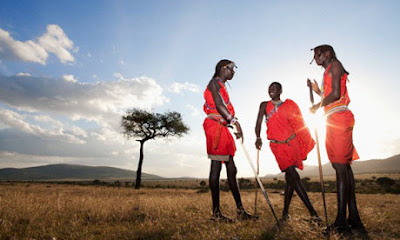National Geographic unveils new phase of Genographic Project
The National Geographic Society has announced the next phase of its Genographic Project -- the multiyear global research initiative that uses DNA to map the history of human migration. Building on seven years of global data collection, Genographic shines new light on humanity's collective past, yielding tantalizing clues about humankind's journey across the planet over the past 60,000 years.
"Our first phase drew participation from more than 500,000 participants from over 130 countries," said Project Director Spencer Wells, a population geneticist and National Geographic Explorer-in-Residence. "The second phase creates an even greater citizen science opportunity -- and the more people who participate, the more our scientific knowledge will grow."
This new stage of research harnesses powerful genetic technology to further explore and document the historic pathways of human migration. Based in part on a unique database compiled during the project's first phase, the next generation of the Genographic Project Participation Kit -- Geno 2.0 -- examines a collection of nearly 150,000 DNA identifiers that offers rich, ancestry-relevant information from across the entire human genome. In addition to learning their detailed migratory history, participants will learn how their DNA is affiliated with various regions in the world, and even if they have traces of Neanderthal or Denisovan ancestry.
Participants will receive their results through a newly designed, multi-platform Web experience at www.genographic.com. In addition to full visualizations of their migratory path and regional affiliations, participants can share information on their genealogy. Already, project results have led to the publication of 35 scientific papers reporting results such as the origin of Caucasian languages and the early routes of migrations out of Africa. Scientific papers have been published in PLOS, Human Genetics, and Molecular Biology and Evolution, among others. DNA results and analysis are stored in a database that is the largest collection of human anthropological genetic information ever assembled.
New to this phase, the project invites grant applications from researchers around the world for projects studying the history of the human species using innovative anthropological genetic tools.
Source: National Geographic Society [December 05, 2012]
"Our first phase drew participation from more than 500,000 participants from over 130 countries," said Project Director Spencer Wells, a population geneticist and National Geographic Explorer-in-Residence. "The second phase creates an even greater citizen science opportunity -- and the more people who participate, the more our scientific knowledge will grow."
This new stage of research harnesses powerful genetic technology to further explore and document the historic pathways of human migration. Based in part on a unique database compiled during the project's first phase, the next generation of the Genographic Project Participation Kit -- Geno 2.0 -- examines a collection of nearly 150,000 DNA identifiers that offers rich, ancestry-relevant information from across the entire human genome. In addition to learning their detailed migratory history, participants will learn how their DNA is affiliated with various regions in the world, and even if they have traces of Neanderthal or Denisovan ancestry.
Participants will receive their results through a newly designed, multi-platform Web experience at www.genographic.com. In addition to full visualizations of their migratory path and regional affiliations, participants can share information on their genealogy. Already, project results have led to the publication of 35 scientific papers reporting results such as the origin of Caucasian languages and the early routes of migrations out of Africa. Scientific papers have been published in PLOS, Human Genetics, and Molecular Biology and Evolution, among others. DNA results and analysis are stored in a database that is the largest collection of human anthropological genetic information ever assembled.
New to this phase, the project invites grant applications from researchers around the world for projects studying the history of the human species using innovative anthropological genetic tools.
Source: National Geographic Society [December 05, 2012]
Reading human history through genetics
Computer scientists at Columbia's School of Engineering and Applied Science have published a study in the November 2012 issue of The American Journal of Human Genetics (AJHG) that demonstrates a new approach used to analyze genetic data to learn more about the history of populations. The authors are the first to develop a method that can describe in detail events in recent history, over the past 2,000 years. They demonstrate this method in two populations, the Ashkenazi Jews and the Masai people of Kenya, who represent two kinds of histories and relationships with neighboring populations: one that remained isolated from surrounding groups, and one that grew from frequent cross-migration across nearby villages.
"Through this work, we've been able to recover very recent and refined demographic history, within the last few centuries, in contrast to previous methods that could only paint broad brushstrokes of the much deeper past, many thousands of years ago," says Computer Science Associate Professor Itsik Pe'er, who led the research. "This means that we can now use genetics as an objective source of information regarding history, as opposed to subjective written texts."
Pe'er's group uses computational genetics to develop methods to analyze DNA sequence variants. Understanding the history of a population, knowing which populations had a shared origin and when, which groups have been isolated for a long time, or resulted from admixture of multiple original groups, and being able to fully characterize their genetics is, he explains, "essential in paving the way for personalized medicine."
For this study, the team developed the mathematical framework and software tools to describe and analyze the histories of the two populations and discovered that, for instance, Ashkenazi Jews are descendants of a small number—in the hundreds—of individuals from the late medieval times, and since then have remained genetically isolated while their population has expanded rapidly to several millions today.
"Knowing that the Ashkenazi population has expanded so recently from a very small number has practical implications," notes Pe'er. "If we can obtain data on only a few hundreds of individuals from this population, a perfectly feasible task in today's technology, we will have effectively collected the genomes of millions of current Ashkenazim." He and his team are now doing just that, and have already begun to analyze a first group of about 150 Ashkenazi genomes.
The genetic data of the Masai, a semi-nomadic people, indicates the village-by-village structure of their population. Unlike the isolated Ashkenazi group, the Masai live in small villages but regularly interact and intermarry across village boundaries. The ancestors of each village therefore typically come from many different places, and a single village hosts an effective gene pool that is much larger than the village itself.
Previous work in population genetics was focused on mutations that occurred very long ago, say the researchers, and therefore able to only describe population changes that occurred at that timescale, typically before the agricultural revolution. Pe'er's research has changed that, enabling scientists to learn more about recent changes in populations and start to figure out, for instance, how to pinpoint severe mutations in personal genomes of specific individuals—mutations that are more likely to be associated with disease.
"This is a thrilling time to be working in computational genetics," adds Pe'er, citing the speed in which data acquisition has been accelerating; much faster than the ability of computing hardware to process such data. "While the deluge of big data has forced us to develop better algorithms to analyze them, it has also rewarded us with unprecedented levels of understanding."
Source: Columbia University [December 05, 2012]
 |
| Tibesmen in the Masai Mara [Credit: Hugh Sitton/Corbis] |
Pe'er's group uses computational genetics to develop methods to analyze DNA sequence variants. Understanding the history of a population, knowing which populations had a shared origin and when, which groups have been isolated for a long time, or resulted from admixture of multiple original groups, and being able to fully characterize their genetics is, he explains, "essential in paving the way for personalized medicine."
For this study, the team developed the mathematical framework and software tools to describe and analyze the histories of the two populations and discovered that, for instance, Ashkenazi Jews are descendants of a small number—in the hundreds—of individuals from the late medieval times, and since then have remained genetically isolated while their population has expanded rapidly to several millions today.
"Knowing that the Ashkenazi population has expanded so recently from a very small number has practical implications," notes Pe'er. "If we can obtain data on only a few hundreds of individuals from this population, a perfectly feasible task in today's technology, we will have effectively collected the genomes of millions of current Ashkenazim." He and his team are now doing just that, and have already begun to analyze a first group of about 150 Ashkenazi genomes.
The genetic data of the Masai, a semi-nomadic people, indicates the village-by-village structure of their population. Unlike the isolated Ashkenazi group, the Masai live in small villages but regularly interact and intermarry across village boundaries. The ancestors of each village therefore typically come from many different places, and a single village hosts an effective gene pool that is much larger than the village itself.
Previous work in population genetics was focused on mutations that occurred very long ago, say the researchers, and therefore able to only describe population changes that occurred at that timescale, typically before the agricultural revolution. Pe'er's research has changed that, enabling scientists to learn more about recent changes in populations and start to figure out, for instance, how to pinpoint severe mutations in personal genomes of specific individuals—mutations that are more likely to be associated with disease.
"This is a thrilling time to be working in computational genetics," adds Pe'er, citing the speed in which data acquisition has been accelerating; much faster than the ability of computing hardware to process such data. "While the deluge of big data has forced us to develop better algorithms to analyze them, it has also rewarded us with unprecedented levels of understanding."
Source: Columbia University [December 05, 2012]

